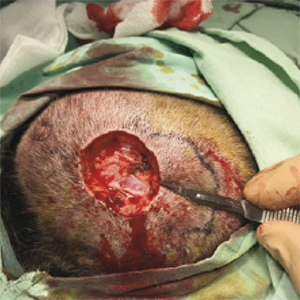Double hatchet flap as adequate dermatosurgical approach for tumours of the occipital scalp zone: Presentation of two cases

HTML: 6
All claims expressed in this article are solely those of the authors and do not necessarily represent those of their affiliated organizations, or those of the publisher, the editors and the reviewers. Any product that may be evaluated in this article or claim that may be made by its manufacturer is not guaranteed or endorsed by the publisher.
Tumors of the scalp remain a serious challenge for clinicians since poor locoregional skin elasticity hinders the ability to utilise certain flaps, limiting the choice of reconstructive techniques available. As a result, surgical restoration of medium to large-sized defects are left to the discretion of the surgeon, who with a comprehensive knowledge of restorative techniques, along with the advantages, limitations as well as a sound understanding of the locoregional anatomy, can make thorough decisions on the choice of which flap is best suited for the defect. Here we present two cases where the double hatchet flap was employed as a dermatosurgical approach in order to provide exceptional cosmetic results. On dermatological examination, both patients presented with a medium to large- sized tumour formation but were otherwise in good health. Both underwent radical, widelocal excision, followed by reconstructive manipulation in the form of a double hatchet flap to close the defect. Postoperative follow- up reported positive signs of wound healing with aesthetically pleasing results. Finally, we discuss the use of various flaps in such conditions while providing evidence for the double hatchet flap as a possible alternative that provides perfect aesthetic results as seen in our cases. Such a complex surgical intervention requires the expertise of a multidisciplinary team in order to achieve an overall successful outcome.
Russo F. Reconstruction of Moderate-Sized Scalp Defects: A 1-2-3 Rule. Actas Dermosifiliogr (Engl Ed) 2019;110:474-481. DOI: https://doi.org/10.1016/j.adengl.2019.05.002
Sun L, Patel AJ. Outcomes of split vs full-thickness skin grafts in scalp reconstruction in outpatient local anaesthetic theatre. Scars Burn Heal 2021;7:20595131211056542. DOI: https://doi.org/10.1177/20595131211056542
Temelkova I, Lotti T, Cardoso JC, et al. Reverdin skin grafting as adequate approach for squamous cell carcinoma of the temporal region. Dermatol Ther 2020;33:e13199. DOI: https://doi.org/10.1111/dth.13199
Varela-Veiga A, Suárez-Magdalena O, Suárez-Amor Ó, Monteagudo B. Double Hatchet Flap for the Reconstruction of Scalp Defects. Actas Dermosifiliogr 2017;108:878-80. DOI: https://doi.org/10.1016/j.adengl.2017.08.006
Fernández-Calderón M, Casado-Sánchez C, Cabrera-Sánchez E, Casado-Pérez C. Versatility of hatchet flaps for the repair of scalp defects. Actas Dermosifiliogr 2012;103:629-31. DOI: https://doi.org/10.1016/j.adengl.2012.08.003
Schultheis K, Kaufmann R, Meissner M. The double hatchet flap as a potential alternative closure technique for scalp defects. J Dtsch Dermatol Ges 2015;13:73-5. DOI: https://doi.org/10.1111/ddg.12373
Jung JE, Rah DK, Kim YO. Effects of preoperative biopsies on recurrence in head and neck skin cancer. Arch Plast Surg 2012;39:518-21. DOI: https://doi.org/10.5999/aps.2012.39.5.518
Fahradyan A, Howell AC, Wolfswinkel EM, et al. Updates on the Management of Non-Melanoma Skin Cancer (NMSC). Healthcare (Basel) 2017;5:82. DOI: https://doi.org/10.3390/healthcare5040082
PAGEPress has chosen to apply the Creative Commons Attribution NonCommercial 4.0 International License (CC BY-NC 4.0) to all manuscripts to be published.





 https://doi.org/10.4081/dr.2022.9487
https://doi.org/10.4081/dr.2022.9487



